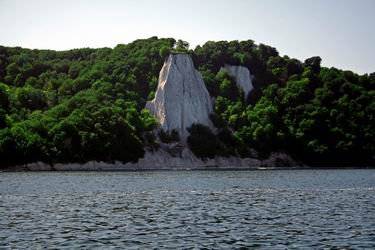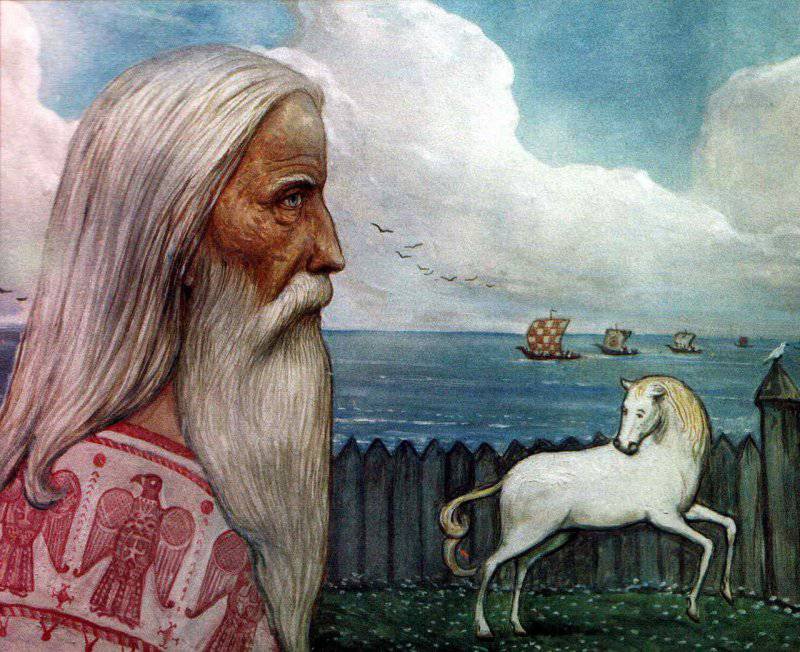Ruyan Island - the sacred center of Slavism
“The island of Buyan in the sea-okayane is where the Kamen-Alatyr is white and flammable (hot) lies, the ancient Pradub is uncovered and powerful, seven heavens pierce, Irii props up”
It should be noted that in the sources of the early Middle Ages, you can see two regions that are associated with "Rus", "Dew", "Rus". This is the region of the southern state center of the Slavs - the Don, the Dnieper and the territory of the Western Slavs - the Slavs-Vends (Varangians). In this article we will cover the topic related history Russ Central Europe.
According to a number of German and Eastern (Arab and Persian) sources, Slavic merchants (“guests”) called themselves “Rus”. So it is reported by the Persian geographer Abul-Qasim ibn Hordadbeh, the author of the Book of Ways and Countries. According to most researchers, the work was compiled in the period from 846-847 - to 885-886 years. Ibn Hordadbeh reports that the Rus are one of the Slav tribes. Ibrahim Ibn Yacoub (10 century of our era), a Muslim of Jewish origin, reports that the Ruses attack Prussians from the west. And the Prussians are a Baltic-speaking people who in the 9th-18th centuries inhabited the territory of the modern Kaliningrad region of Russia, part of the Lithuanian Klaipeda district and the Polish Warmian-Masurian voivodship.
Such sources as the Danish chronicler Saxon Grammar (about 1140 - after 1208) were placed in the region of residence of the Slavs-Vends, Rus, the Polish Latin-language document relating to the 990-992 years “Dagome Judex” - informs about the place of Russe adjacent to Prussia, North German chronicler Adam of Bremen (died after 1081 of the year), the author of the “Acts of the Bishops of the Hamburg Church,” wrote that the Prussians border on the Rus. There is information about this in other sources as well, in the thirteenth century papal bulla Russia is located between Slavia (the land of the Pomeranian Slavs) and Prussia.
Interestingly, this information is indirectly confirmed by later Russian sources, as in the "Tale of the Princes of Vladimir" it is reported that Rurik came from the Prussia region.
Some sources refer to the "island of the Rus". The Persian scholar and encyclopaedist of the 1 of the 10th century, Ibn Ruste, in his work Dear Values, reports that the Ruses live on an island surrounded by sea (lake), they are ruled by the Khakan of the Ruses, and they use ships for attacks. It is reported that "healers" are so respected that they can command the king. This fact clearly indicates the island of Ruyan (Rugen), where one of the most important sacral centers of the Slavs was located - the temple-city of Arkona. It is reported about their belligerence: they are "brave and courageous, and if they attack another people, they do not lag until they completely destroy them." In addition to war, the population of the island is engaged in trade. This news is fully correlated with the image of the Vikings.
Interesting and the title of ruler Rusov - Khakan. This is an imperial title, in the East this word designated the czar-priest, the sacred sovereign who combined administrative functions with spiritual authority. Later also called some of the great princes of Kiev-Novgorod Russia. German documents of that time were called "kings" only by two rulers of Slavs - the ruler of the great Novgorod-Kiev Russia and the owner of a small island off the coast of the Baltic Sea. The rulers of the Czech Republic and Poland were called "princes."
 Ruyan Island inhabited the Ruian tribe (rugov, wounds). Confirms the fact of the identity of the Rus-Varangians and the Rus of Old Russia and the fact that the medieval Germanic documents regularly call the Eastern (Kiev) Rus - rugs. And the inhabitants of Ruyan are often called ruthen-rusami, and their country Rusia-Rutenia. The most important shrine of the Slavs - the temple of Svyatovit (Sventovit) - was located on Ruyan. A third of all of their war booty was given to the temple. The temple of the four-faced god was located in the city of Arkona, in the sanctuary, besides the idol, there were sacred things - a bridle, a saddle and a huge battle sword and shield, as well as a village. The village was called the holy banner of Svyatovit, and carried before the army in a campaign or battle. Arkona was the main center of divination, believed that Sventovit gives the most accurate predictions (analogue of the ancient Greek Delphic oracle). Gifts to the temple were not only from Ruyans, but also from pilgrims and entire tribes, lands of Slavs, even foreign rulers. The temple was defended by a sacred squad of 300 knights on white horses ("white squad"). There selected the best warriors of the Slavic lands.
Ruyan Island inhabited the Ruian tribe (rugov, wounds). Confirms the fact of the identity of the Rus-Varangians and the Rus of Old Russia and the fact that the medieval Germanic documents regularly call the Eastern (Kiev) Rus - rugs. And the inhabitants of Ruyan are often called ruthen-rusami, and their country Rusia-Rutenia. The most important shrine of the Slavs - the temple of Svyatovit (Sventovit) - was located on Ruyan. A third of all of their war booty was given to the temple. The temple of the four-faced god was located in the city of Arkona, in the sanctuary, besides the idol, there were sacred things - a bridle, a saddle and a huge battle sword and shield, as well as a village. The village was called the holy banner of Svyatovit, and carried before the army in a campaign or battle. Arkona was the main center of divination, believed that Sventovit gives the most accurate predictions (analogue of the ancient Greek Delphic oracle). Gifts to the temple were not only from Ruyans, but also from pilgrims and entire tribes, lands of Slavs, even foreign rulers. The temple was defended by a sacred squad of 300 knights on white horses ("white squad"). There selected the best warriors of the Slavic lands.The island of Rugen-Ruyan consists of chalk rocks covered with lush vegetation. Tourists who come here often go to look at the majestic white cliffs. According to legend, in order to confirm his title and the right to power, the future King of the Rus (Khakan) had to rise from the foot of the cliff to the top from the side of the Varangian Sea. The sacred white rock of the “Island of the Rus” seemed to claim the sacred right to power with its unshakable grandeur. Apparently, the memory of the “white stone of Alatyr” has been preserved in the Russian tradition since that time. The northern tip of the island of Ruyan (Buyan Russian fairy tales) far issued into the Baltic Sea. A cape with steep chalk cliffs in ancient times was called Arkona. This word is translated as "white mountain" (from ind-euro. Ar, arya - "white, noble" and horse - "mountain").
With Rurik and other Vikings-Rus, part of the traditions of the Arkonish cult was preserved in Eastern Russia (the conventional name, like "Kievan Rus", the Rus themselves called their land - "Russia", "Russian land"). So, apparently from the Arkons and more widely of all the Western Russian lands, such images came as: a white warrior warrior in Russian epics and fairy tales, bringing victory and success to his master and at the same time possessing the properties of an oracle prophet giving clues to the host; the heroic “sword of kladenets” mentioned in the heroic epic; magic bridle (horse Svyatovita); horseshoe on the door to scare away evil spirits (symbol of the white horse Svyatovit); White horse character in the rite of Kolyada. The language of characters in the epic series about “Ilya of Murom” shows the transfer of power, the sword to the Russian hero Ilya of Murom (Perun) from Svyatogor (Arkonsky Svyatovit), etc. From there, the stone-combustible Alatyr Stone, which is regularly remembered in Slavic plots, came.
The idea to invoke from the island of Ruyan-Rus, where one of the main shrines of Slavism was located, the rules of "Khakan", the tzar-priest, the ruler, is quite logical. The citizens of Gostosmysl could well turn to their Western brethren on this issue. In addition, there is evidence that Rurik was the grandson of the ruler of Sloven - Gostosmysl, the son of his daughter Umila.

Information